|
Broad Street Basin
part 2 The Temporary
Railway Station |
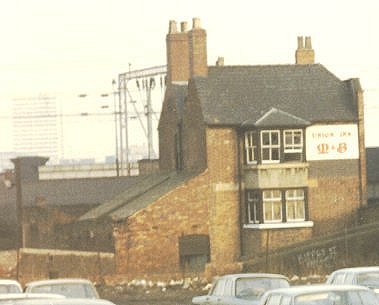
The railway station is the brick building behind the
lean-tos at the rear of the Union Inn. |
The Union Inn stood next to
the first railway station to be built in the
centre of Wolverhampton. It was owned by the
Shrewsbury & Birmingham Railway Company and
designed by their architect Edward Banks. The
station was built by William Jarrow of Leicester
at a cost of £380.
The Shrewsbury & Birmingham
Railway also built the original High Level
station, and had a half share in the project
with the London and North Western Railway.
Unfortunately building work
was delayed because of the decision to divert
the canal. This problem was overcome by the
building of the temporary station which enabled
the company’s trains to operate while work was
in progress on the High Level Station. |
| The temporary station opened on 12th
November, 1849 and had a single platform on top
of the railway embankment, with a walkway down
to the station. There was a loading area with
a track at the rear of the building. The
station closed when the high Level station
opened on 24th June 1852.
After closure the building was used as a
Sabbath School, and later sold to the Shropshire
Union Railway and Canal Company for use as a
stable block and general storehouse.
In later years it was used by Dent and
Partners Limited who were builders, and Midland
Painting Limited. |
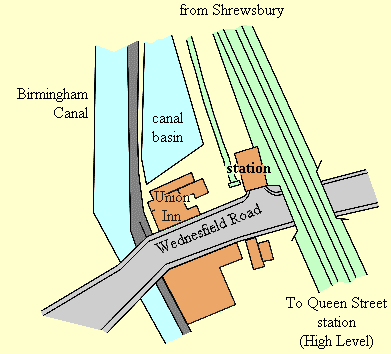
The location of the
temporary station. |
 |
The Hay Basin and wharf was built in 1850
and originally called the Albert Basin. It
quickly became known as the Hay basin because
large quantities of hay were transported here.
Work on the wharf began in April 1850. It soon
became the scene of a riot between two opposing
railway companies, the Shrewsbury & Birmingham
Railway Company and the London & North Western
Railway.
After the opening of the
temporary railway station in 1849 the
relationship between the Shrewsbury & Birmingham
Railway Company, and the London & North Western
Railway became problematic.
The North Western went into
direct competition with the S&B by reducing
fares on the Shropshire Union line from Stafford
to Shrewsbury. The Shrewsbury & Birmingham
immediately sought, and got an injunction to
prevent this practice, but the London & North
Western successfully opposed it. A long legal
battle and a price war commenced. |
| The London & North Western retaliated by
delaying the opening of the Stour Valley Line to
prevent the Shrewsbury & Birmingham company’s
trains from travelling to Birmingham.
The Shrewsbury and Birmingham was getting
increasingly frustrated because it still
couldn't send its freight to Birmingham by
train, and so decided on a different approach.
The Birmingham Canal ran alongside the track,
and was seen as a convenient alternative.
On Friday 12th July a group
of Shrewsbury & Birmingham workmen were fitting
an access gate into the boundary fence when the
London & North Western decided to stop them. Mr.
Moore, one of the Stour Valley's contractors
sent a gang of men to stop the work.
An argument followed
between Mr. Moore and the Shrewsbury &
Birmingham's engineer, Henry Robertson. Soon
some 300 Stour Valley workmen, all armed with
spades, pick axes or the tools of their trade
descended on the scene to halt the work once and
for all. They were soon followed by a Shrewsbury
& Birmingham train which brought about 200 men
to the scene, also similarly armed, and
distinguished by arm bands made of red tape.
Soon fighting began, and the Mayor, who summoned
the police and army, read the Riot Act. The two
factions were separated, and a series of legal
battles began.
In the 1920s the Hay Wharf
and Basin was used by the Midland & Coast Canal
Carriers Limited, formed in April 1922. They
were taken over by Fellows, Morton and Clayton
Limited on 1st July, 1938.
Toll House and
Lock Keeper's Cottage |
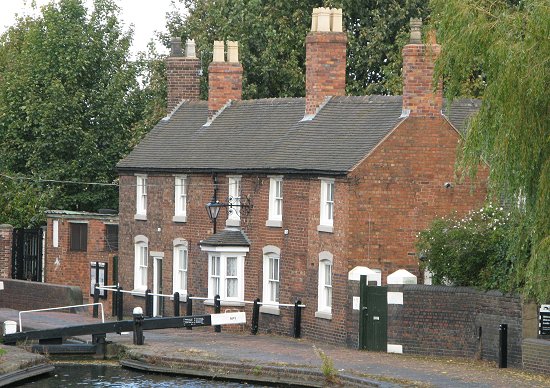 |
The cottages date from the late 18th
century, but are much altered, as can be seen
from the changes made to the brickwork on the
front. |
| This sketch by the late Ron Eason shows
differences in the brickwork. |
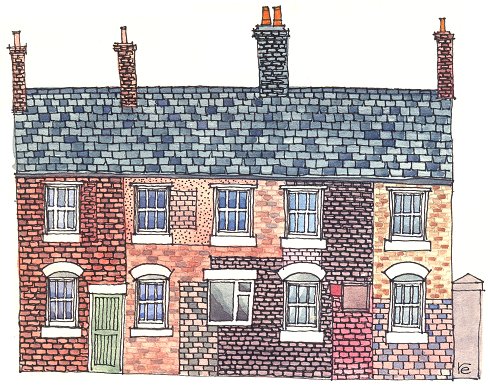 |
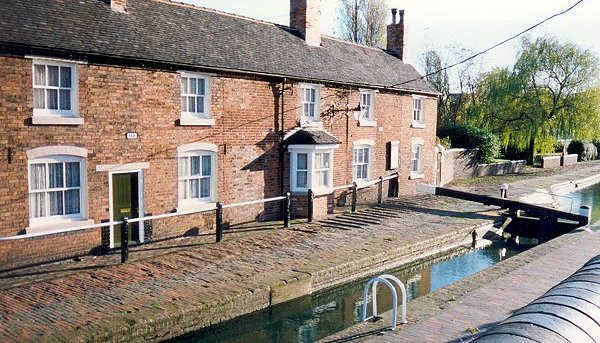
Since the late 1970s a bay window has
been added.
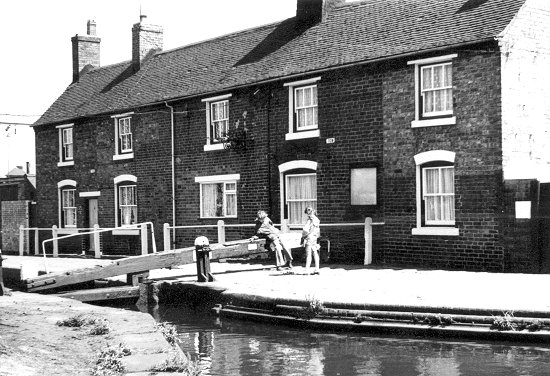 |
This view from 1978
was taken by the late Ron Eason. |
| In the 1930s the BCN agent was Mr. L.
Hadley, at the Toll Office, Canal Side (top
lock).
A photograph showing
the cottages, top lock and Littles Lane Bridge
that carries Lock Street over the canal. |
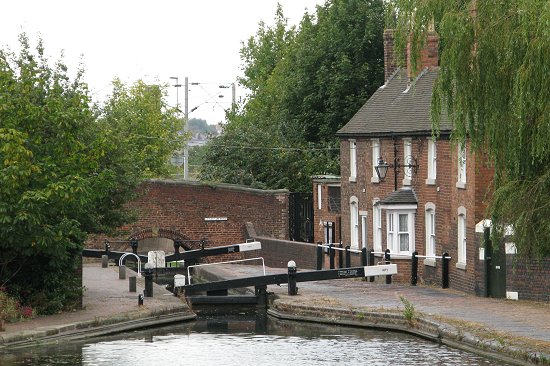 |
|
The
Mission Room
There were several mission
rooms on the BCN. Three of them were run by the
Incorporated Seamen and Boatmens Friend Society
formed in 1846. Their mission rooms were at
Worcester Wharf, Birmingham, Hednesford Basin on the
Cannock Extension, and the Boatman’s Rest at
Walsall. Independently financed missions were also
built at Tipton, and at top lock Wolverhampton.
The missions held services for
boat families, and provided tea, coffee, food,
tobacco, newspapers, and periodicals. They had
washing facilities and board games such as chess,
and draughts for the long evenings. The volunteers
at the mission rooms would also write letters for
illiterate boatmen, and attempt to educate boat
families’ children.
The single storey building by
top lock had a bell and short bell tower. The
mission room is marked on the 1899 Wolverhampton
map, but had closed within a few years. |

Sablon Welding Company's building.
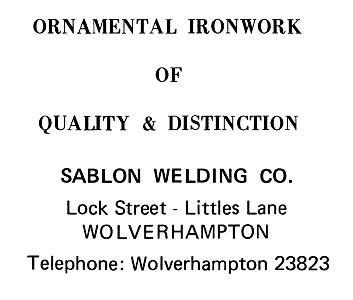 |
The mission building was demolished and
rebuilt as a workshop for the Sablon Welding
Company who were in existence until recent
times.
The company produced ornamental ironwork such
as railings and gates. |
| Some of the
company's products: |

 |
Return to the
previous page |
|